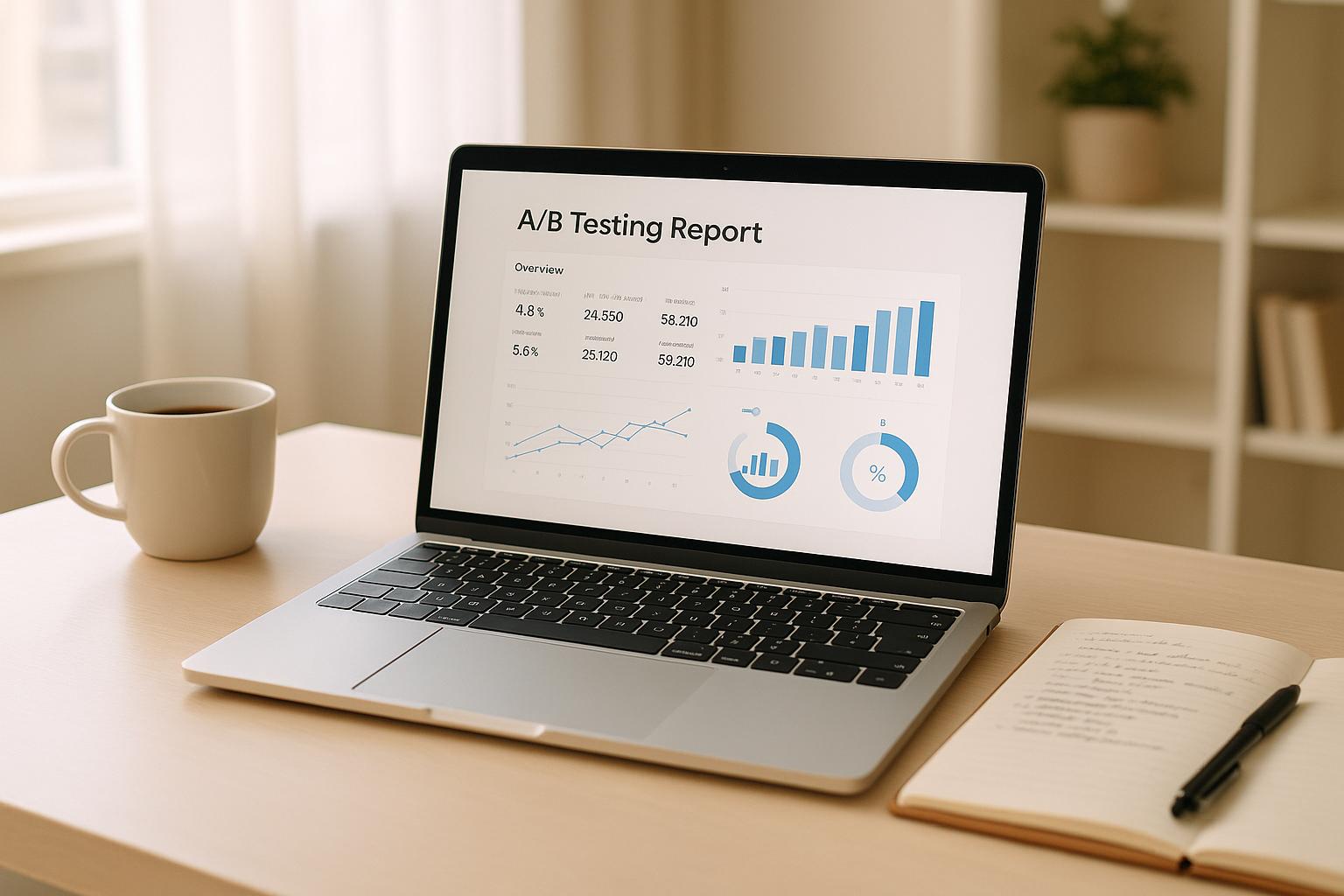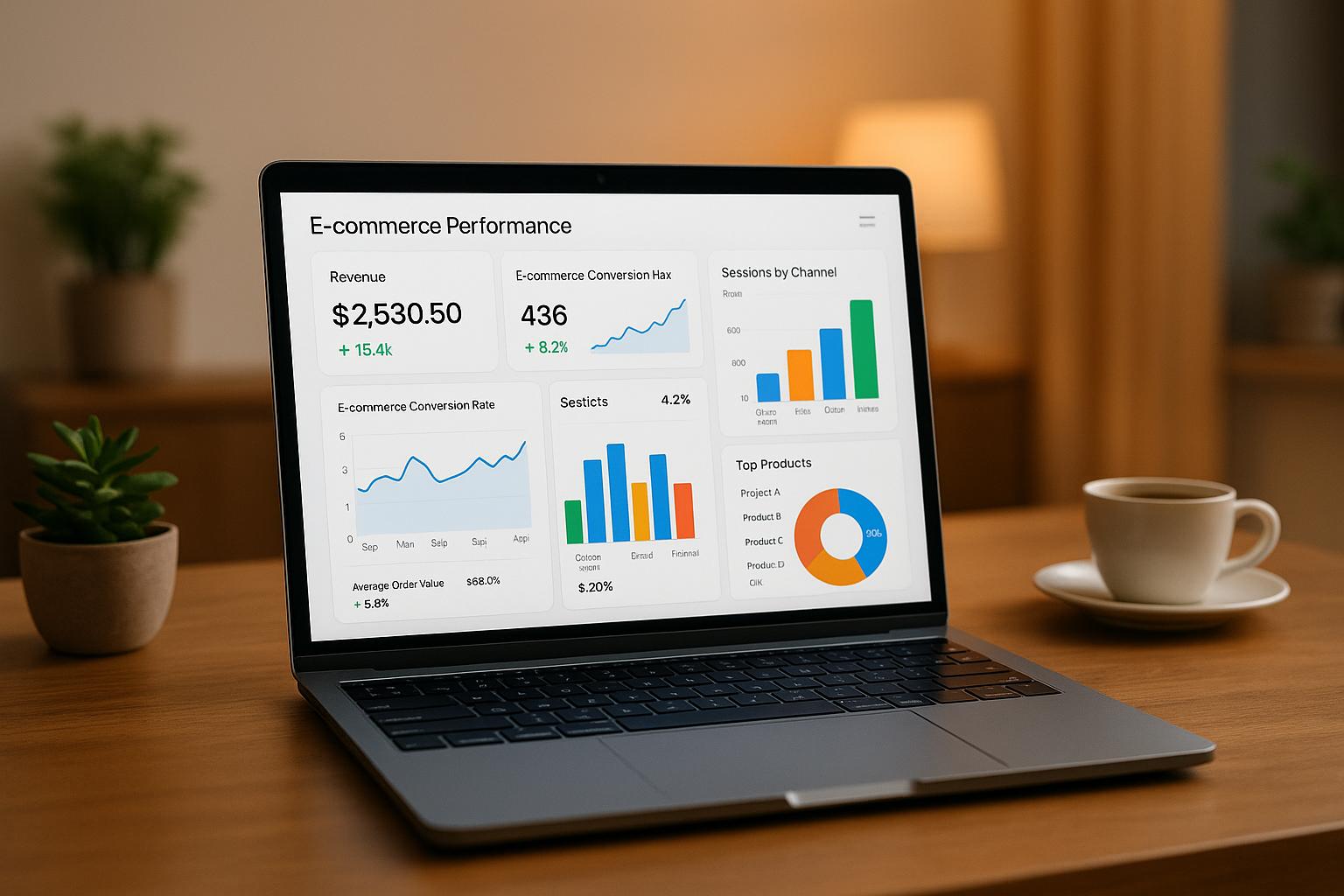AI-powered BI tools are reshaping how businesses analyze and act on data in 2025. These platforms automate insights, detect patterns, and predict trends, making decision-making faster and more precise. Choosing the right tool depends on your organization's goals, infrastructure, and expertise. Here’s a quick breakdown of the top platforms:
- Microsoft Power BI: Ideal for businesses in the Microsoft ecosystem. Offers AI-driven natural language querying, automated reporting, and robust integrations with tools like Excel and Azure.
- Tableau (Salesforce): Focuses on visual analytics with AI assistance for creating calculations and visualizations. Best for teams prioritizing detailed data storytelling and Salesforce integration.
- Google Cloud Looker: Perfect for organizations using Google Cloud. Features code-based modeling for consistent metrics and scalable cloud-native architecture.
Quick Comparison:
| Platform | Strengths | Limitations |
|---|---|---|
| Microsoft Power BI | User-friendly, integrates with Microsoft tools | Advanced AI requires higher-tier licensing |
| Tableau (Salesforce) | Advanced visual analytics, Salesforce integration | Higher cost, steeper learning curve |
| Google Cloud Looker | Scalable, optimized for Google Cloud | Requires technical expertise |
Key factors to consider:
- AI features: Predictive analytics, natural language processing, and automated insights.
- Integration: Compatibility with ERP, CRM, and data warehouses like Snowflake or BigQuery.
- Security: Encryption, access controls, and compliance with GDPR or SOC 2 standards.
These platforms streamline BI workflows, but the best choice depends on your data strategy, team skills, and budget. Always test usability and integration with your existing systems before committing.
Top 10 AI-Powered Business Intelligence Platforms
Key Factors for Selecting AI BI Platforms
Choosing the right AI BI platform can make or break your data strategy. Since platforms differ in their strengths - some excel in predictive modeling, others in natural language processing (NLP) or real-time analytics - it’s essential to match these capabilities with your organization’s specific needs.
Let’s dive into three critical areas to consider: AI and machine learning features, system integration and compatibility, and data security and compliance requirements.
AI and Machine Learning Features
The core AI capabilities of a platform determine how well it can transform raw data into actionable insights. For example, predictive analytics can help forecast trends, pinpoint risks, and optimize operations before problems arise, making it indispensable for proactive decision-making.
Platforms with automated pattern recognition are particularly valuable for tasks like flagging unusual financial transactions or detecting equipment issues - no manual setup required. This feature saves time and ensures continuous monitoring.
NLP takes usability to the next level. Imagine asking, “What were our top-performing products last quarter in the Northeast?” and getting a clear, instant answer. This kind of plain-language interaction lowers the learning curve, making the platform accessible across departments, even for non-technical users.
Generative AI tools are another game-changer. They can automatically generate visualizations, craft executive summaries, and suggest next steps based on your queries. For example, a platform might summarize a sales report and propose follow-up questions like, “Would you like to see a breakdown by region?” These features help bridge the gap between data teams and business stakeholders by making insights easier to understand and act upon.
Some platforms offer pre-built models, such as churn prediction, while others provide frameworks for custom model development. The right choice depends on your team’s expertise - do you need ready-to-use solutions, or does your team have the skills to create and manage custom models?
System Integration and Compatibility
A BI platform’s ability to integrate seamlessly with your existing systems is crucial. API compatibility ensures smooth data flow between the platform and your core business tools, laying the groundwork for a unified data ecosystem.
For most enterprises, ERP system integration is non-negotiable. Whether you’re using SAP, Oracle, or Microsoft Dynamics, the platform should include native connectors or robust APIs to synchronize data in real time without slowing down performance.
CRM connectivity is equally important for customer analytics. By integrating with platforms like Salesforce, HubSpot, or Microsoft Dynamics 365, you can combine sales data with behavioral insights for a 360-degree view of the customer journey and better revenue attribution.
When it comes to leveraging your data infrastructure, data warehouse compatibility is key. The platform should support popular cloud-based solutions like Amazon Redshift, Google BigQuery, and Snowflake, as well as traditional on-premises systems like Microsoft SQL Server and Oracle Database.
Flexibility across cloud providers - such as AWS, Microsoft Azure, and Google Cloud Platform - lets you avoid vendor lock-in while optimizing costs. This adaptability is especially useful as your infrastructure evolves.
Finally, platforms with robust third-party tool ecosystems can extend their capabilities. Whether it’s specialized analytics tools or industry-specific applications, these integrations make it easier to tailor the platform to your unique workflows.
Data Security and Compliance Requirements
Security and compliance are non-negotiable when handling sensitive data. Platforms must meet enterprise-grade encryption standards, such as AES-256, for data both at rest and in transit.
Granular access control is another must-have. Features like role-based access control (RBAC) and attribute-based access control (ABAC) allow administrators to limit data access based on user roles or specific attributes, ensuring sensitive information stays protected.
Regulations like CCPA and GDPR add another layer of complexity. For CCPA compliance, platforms should offer tools for data lineage tracking, deletion, and audit trails, enabling you to manage personal data efficiently. GDPR compliance requires features like data residency controls, consent management, and tools to handle data subject requests.
Certifications matter, too. SOC 2 Type II certification is now a baseline for enterprise BI platforms, signaling that the vendor has strong security controls in place. Additional certifications like ISO 27001 and FedRAMP are essential for organizations with stricter requirements.
Audit logging is critical for both compliance and security. Platforms should track all user activities, data access events, and system changes, with tamper-proof logs that can be exported for audits or investigations. Automated compliance reporting tools can also save countless hours during regulatory reviews.
Lastly, data residency controls are vital for industries with strict geographic data storage requirements. Being able to specify where your data is stored ensures compliance with both regulatory and internal policies.
Top AI Platforms for Enterprise BI in 2025
As enterprise BI continues to evolve, AI-powered platforms are setting the pace for innovation. Below are three standout platforms leading the market in 2025, each offering unique benefits depending on your business needs and tech stack.
Microsoft Power BI
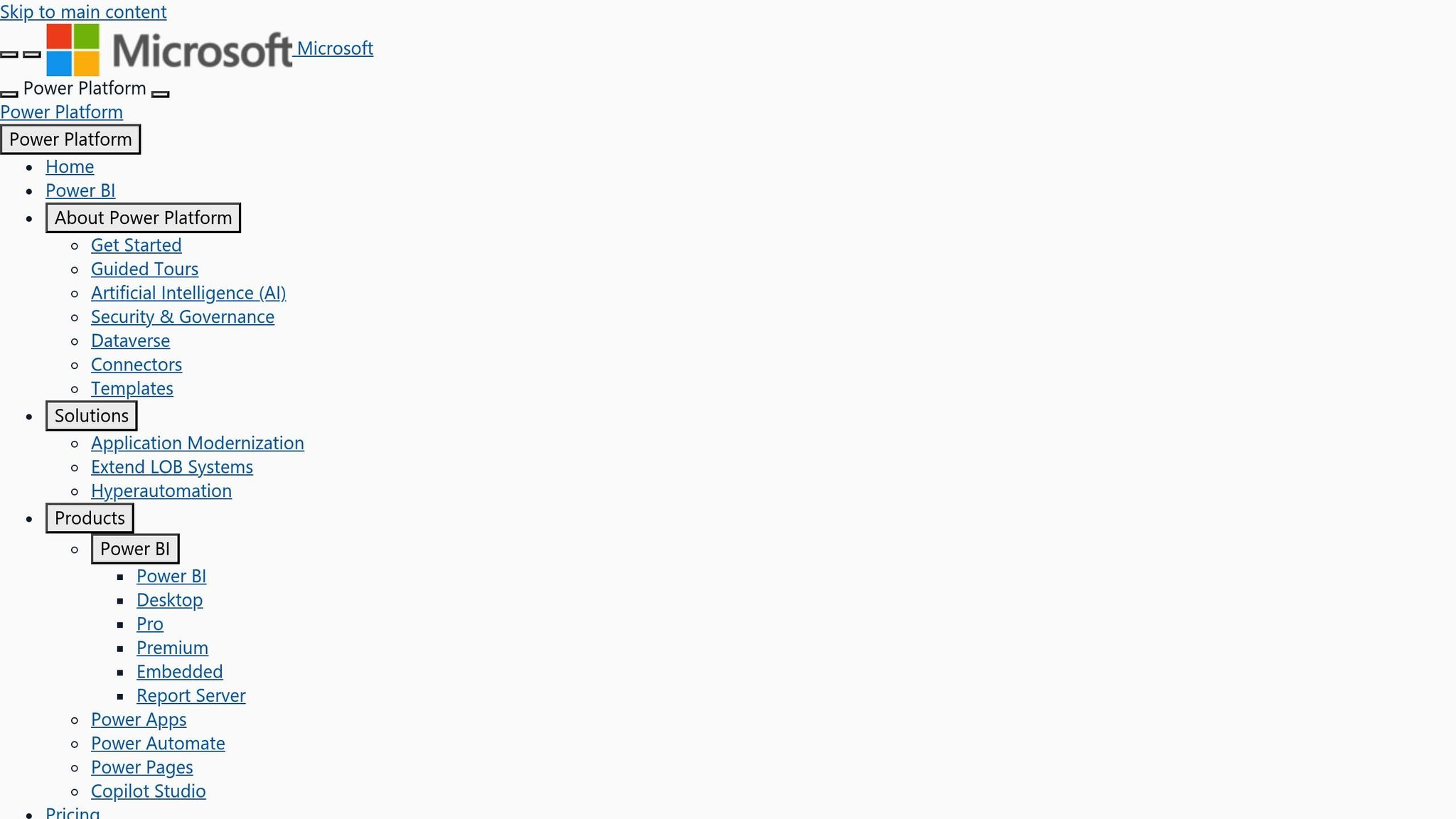
Microsoft Power BI stands out as a leader in enterprise BI, especially for organizations already embedded in the Microsoft ecosystem. Its flagship AI feature, Copilot, simplifies tasks like natural language queries and automated report creation. Impressively, over 85% of Fortune 500 companies use Microsoft's AI solutions.
Power BI's AI capabilities go far beyond basic analytics. With Copilot, users can create DAX queries, build visuals from simple prompts, and even generate full report pages automatically. Updates released in August 2025 enhanced AI integration for reporting and modeling, making complex data analysis more accessible for non-technical users.
Additional features further enhance Power BI's capabilities:
- AI Data Schema (currently in preview): Allows admins to focus AI responses on specific data subsets.
- Verified Answers: Links trusted visuals to trigger phrases for more reliable insights.
- AI Instructions: Adds business context and domain-specific logic to improve AI-generated outputs.
Power BI's tight integration with Microsoft products like Excel, Teams, PowerPoint, and Azure makes it a natural choice for businesses already using these tools. Enhanced connectors also simplify the process of unifying data from diverse sources.
However, Copilot's functionality requires Premium capacities, which might pose challenges for smaller organizations. For those seeking a visually focused approach, Tableau offers an alternative solution.
Tableau (Salesforce)
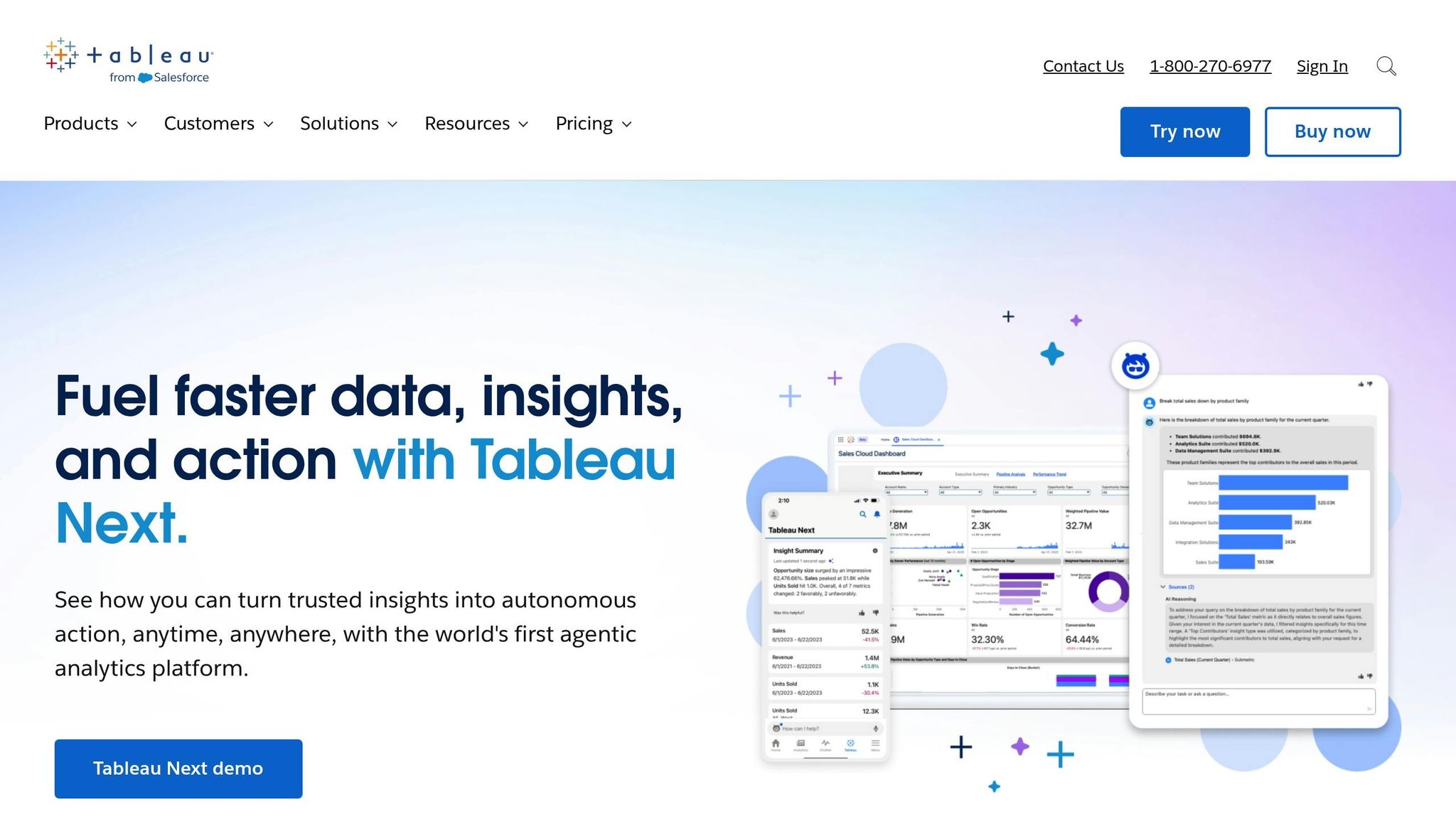
Tableau, powered by Salesforce's Einstein Trust Layer, is a leader in visual analytics. Its focus is on making data analysis accessible while maintaining strict data governance.
The Tableau Agent (formerly Einstein Copilot) acts as an AI assistant, helping users prepare data, create calculations, and generate visualizations through conversational prompts. This feature makes advanced analytics approachable, even for those without technical expertise. Additionally, Tableau Pulse delivers tailored insights by automatically identifying trends and anomalies, ensuring decision-makers have the information they need without extensive searching.
For Salesforce users, Tableau provides deep integration with tools like Salesforce CRM, Data Cloud, and CRM Analytics, creating a unified view of customer and business data. Tableau Semantics ensures consistency by linking governed data models with visualizations.
Tableau also supports extensive third-party integrations through its open architecture. Exchange connectors enable compatibility with platforms like Databricks, DuckDB, and MongoDB. Collaboration tools like Slack and Google Workspace, integrated into Tableau Next, further streamline teamwork and insight sharing.
Google Cloud Looker
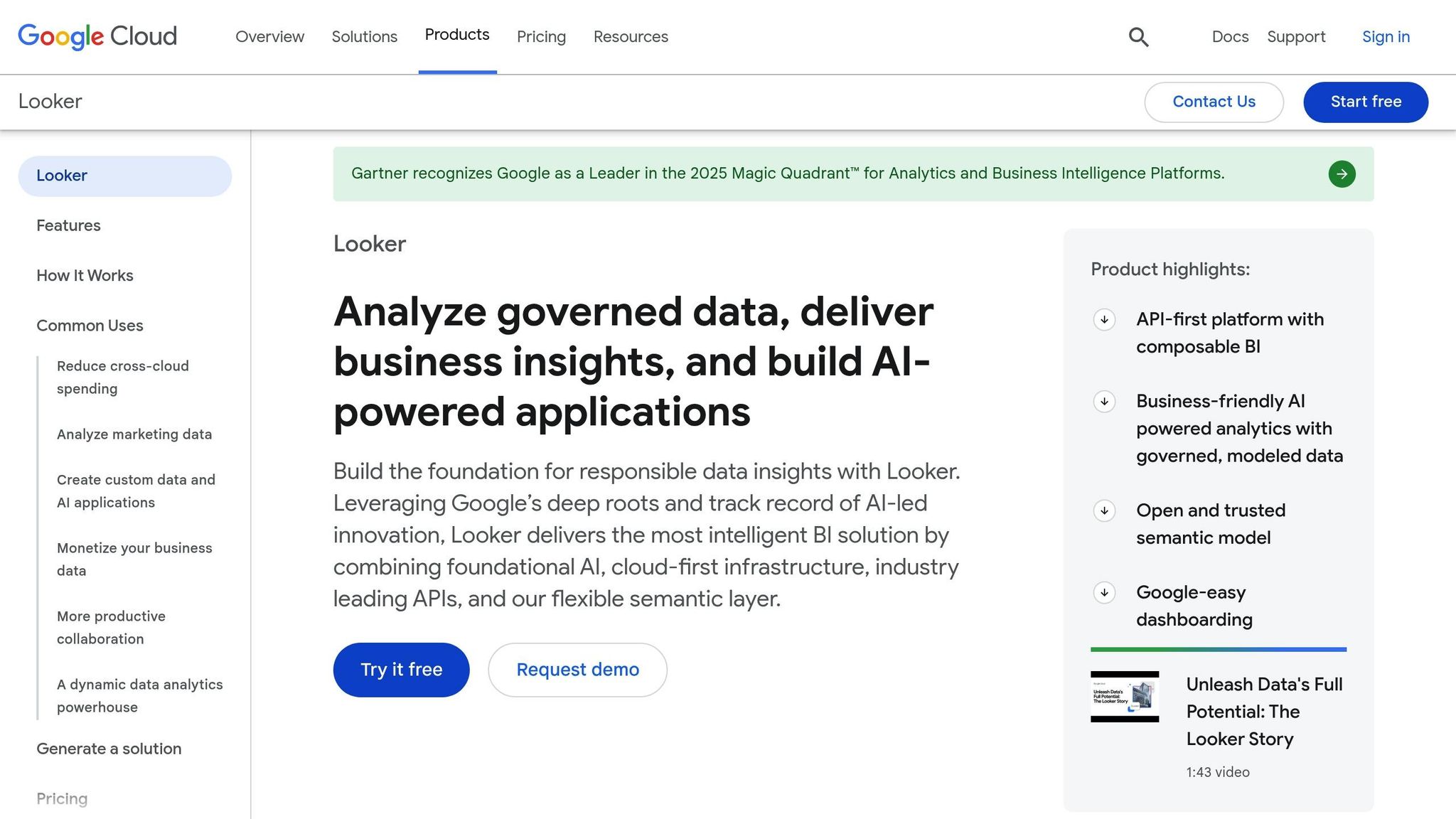
For businesses leveraging Google Cloud infrastructure, Google Cloud Looker is a top choice. Built for scalability, Looker excels in handling big data and rapid growth while maintaining high performance.
At the heart of Looker is LookML, a modeling language that allows data teams to define and reuse business logic across analyses. This ensures consistent metrics and reduces maintenance efforts. Teams can also use version control to manage updates and deploy changes systematically.
Looker's cloud-native architecture automatically scales to handle large datasets, eliminating the management headaches of traditional BI tools. Its semantic modeling defines business rules at the data layer, creating a single source of truth and reducing inconsistencies across analyses.
For organizations already using Google Cloud services like BigQuery and Google Analytics, Looker integrates seamlessly, delivering optimized performance. It also taps into Google Cloud's AI and machine learning tools, enabling advanced analytics without complex data migrations.
The value of AI in enterprise BI is clear - businesses investing $1 in generative AI are seeing an average return of $3.70. Platforms like Looker, Tableau, and Power BI are driving this transformation, making AI an indispensable part of modern business intelligence.
sbb-itb-5174ba0
Platform Comparison: Features and Limitations
Here's a breakdown of the key AI features, strengths, and limitations of some leading business intelligence platforms:
| Platform | Key AI Features | Primary Strengths | Main Limitations |
|---|---|---|---|
| Microsoft Power BI | AI-enhanced natural language querying and automated reporting | Seamless integration with the Microsoft ecosystem and user-friendly for non-technical users | Advanced AI features require higher-tier licensing, limiting customization |
| Tableau (Salesforce) | AI-driven insights with enhanced data governance | Exceptional visual analytics and broad support for third-party integrations | Steeper learning curve and higher costs for advanced functionalities |
| Google Cloud Looker | Code-based data modeling integrated with cloud AI tools | Cloud-native scalability with strong Google Cloud integration | Requires technical expertise and is best suited for Google Cloud users |
Performance and scalability vary across these platforms, with each excelling in specific areas based on its design and integration focus.
Tableau stands out for its robust visual analytics, making it an excellent choice for businesses that emphasize detailed data visualization and storytelling. Its ability to handle complex datasets and present them in an intuitive, visually engaging way is a significant advantage for enterprises focused on data-driven narratives.
Google Cloud Looker takes a more technical, code-centric approach to data modeling, which helps ensure consistency in large-scale analyses. Its cloud-native architecture is ideal for organizations already embedded in the Google Cloud ecosystem, offering reliable scalability and performance. However, its reliance on technical expertise can be a hurdle for less tech-savvy teams.
These comparisons provide a snapshot of how each platform fits into the broader enterprise BI landscape. The right choice ultimately hinges on your organization's technical setup, the balance you need between ease of use and advanced features, and your team's ability to harness AI-driven insights effectively.
How to Select the Right AI BI Platform for Your Enterprise
Choosing the right AI-powered BI platform means aligning your selection process with your organization's unique needs and goals.
Start by assessing your current infrastructure and technical setup. For example, Power BI works seamlessly with Microsoft tools like Office 365 and Azure. Looker, on the other hand, is optimized for Google Cloud users, offering cost advantages through native cloud integration. Tableau stands out for its ability to connect with a wide range of third-party tools, making it a strong choice for organizations requiring diverse integrations.
Take your team's expertise into account. If your team includes non-technical users, Power BI's natural language querying can be a game-changer. Meanwhile, Looker’s code-based modeling is better suited for organizations with data scientists and developers who can leverage its advanced capabilities.
Factor in your budget - beyond just licensing fees. While Power BI offers competitive entry-level pricing, its advanced AI features are available only in higher-tier plans, which can increase overall costs. Tableau, known for its premium pricing, provides sophisticated visualization tools, making it a worthwhile investment for teams focusing on complex analytics and data storytelling. Don’t forget to include other costs like training, implementation, and ongoing maintenance when calculating your total investment.
Address compliance and security needs. If your organization operates in a regulated industry, you’ll need a platform that meets strict data governance standards. Each major platform takes a different approach: Power BI benefits from Azure’s robust compliance certifications, Looker offers strong data governance through its modeling layer, and Tableau provides flexible security options tailored to enterprise needs.
Test user adoption early in the process. Low adoption rates can undermine even the best BI tools. Running pilot programs with end users can help gauge usability. Power BI’s Microsoft-based interface often leads to higher adoption among office workers, while Tableau’s more complex interface may require additional training to ensure widespread use.
Plan for scalability and future growth. Think about how each platform will handle increasing data volumes and user demands. Looker’s cloud-native design automatically scales with your needs, making it ideal for fast-growing organizations. Power BI also scales effectively within the Microsoft ecosystem but may face challenges when integrating with non-Microsoft data sources at an enterprise level.
Once you've reviewed technical capabilities and scalability, external resources can provide valuable insights. For instance, the Marketing Analytics Tools Directory is a helpful resource for comparing BI platforms and other analytics tools. It allows organizations to evaluate features, pricing, and capabilities across multiple solutions, simplifying the process of finding a platform that matches both business needs and technical constraints.
Finally, prioritize integration with your existing data stack. The best AI BI platform is one that works seamlessly with your current data sources, databases, and business applications. During your evaluation, test how each platform handles your specific data formats, API connections, and real-time data streaming needs to ensure a smooth fit with your existing infrastructure.
Conclusion
The world of AI-driven business intelligence in 2025 offers companies the chance to turn raw data into actionable insights. Tools like Microsoft Power BI, Tableau, and Google Cloud Looker each bring something distinct to the table, whether it's seamless integration, advanced data visualization, or cloud-first architecture.
The key to success lies in choosing a platform that fits your business goals and existing infrastructure. It's important to remember that the priciest option isn't always the smartest choice. Instead, focus on finding a solution that aligns with your current needs while offering the flexibility to grow with your business.
Keep in mind, though, that adopting AI-powered BI involves more than just purchasing a license. You'll need to account for implementation, staff training, and ongoing maintenance when calculating the total investment. Companies that take a comprehensive approach - like running pilot tests with real users - often see better adoption rates and stronger returns on their investment.
To make your evaluation process easier, consider using trusted resources. For example, the Marketing Analytics Tools Directory provides detailed comparisons of features, pricing, and capabilities for various BI platforms. It's a valuable tool for identifying solutions that meet your technical and business needs, whether you're looking for enterprise analytics, reporting dashboards, or other BI functionalities.
As we look ahead, the future of enterprise BI lies in platforms that combine AI capabilities, intuitive design, strong security, and seamless integration. By carefully evaluating your requirements and leveraging resources like comparison tools, you'll be well-equipped to choose a platform that delivers real business impact in 2025 and beyond.
FAQs
How do AI-driven BI platforms improve decision-making for enterprises?
AI-powered business intelligence (BI) platforms are reshaping how businesses make decisions. By using machine learning, predictive analytics, and natural language processing, these tools can process and analyze massive datasets in real time. This capability allows teams to quickly identify patterns, spot opportunities, and tackle challenges with precision.
With automated data analysis and visualization, these platforms cut down on manual work and improve decision accuracy. They also offer features like trend forecasting and autonomous decision-making, which help businesses adapt and stay competitive in fast-paced markets.
What should businesses consider when integrating AI-powered BI platforms with their current data systems?
When bringing AI-powered business intelligence (BI) platforms into your current data systems, there are three key areas to prioritize: data quality, compatibility, and security.
Start by conducting a thorough audit of your existing systems. This helps pinpoint data silos or inconsistencies that could disrupt integration. Creating a unified data architecture is a smart way to ensure data flows smoothly, paving the way for real-time insights.
It's also crucial to confirm that the BI platform integrates seamlessly with your enterprise systems, like ERP or CRM platforms. Compatibility is key to avoiding operational hiccups. And don’t overlook security - implement strong measures to safeguard sensitive business data throughout the integration process.
A well-thought-out, step-by-step plan can help reduce risks and ensure you get the most value out of your BI platform.
What steps can businesses take to ensure data security and compliance when using AI-powered BI tools?
To keep data secure and stay compliant while using AI-powered BI tools, businesses should prioritize strict access controls, data encryption, and ongoing monitoring. These steps are key to safeguarding sensitive information and blocking unauthorized access.
On top of that, using AI-driven compliance tools can make regulatory tasks easier by automating audit preparations and offering real-time compliance tracking. Staying up-to-date with changing regulations and establishing a strong governance framework are also essential for protecting data and ensuring your organization adheres to all legal standards.

